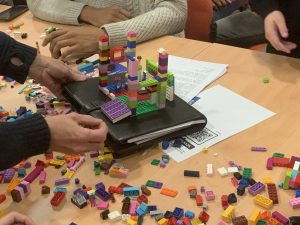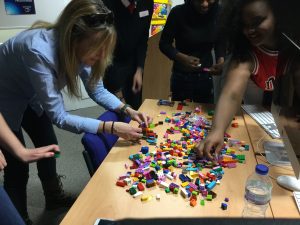Serious play: active learning with Lego bricks
Dr Bianca Fox
What is the idea?
This case study explores ways of using Lego play in teaching undergraduate students and shows evidence of the Lego play efficacy in helping first year students build relationships and participate in active learning activities.
Why this idea?
Scholars believe that Lego is a ‘tool for thinking’ (Gauntlett, 2007) with great potential to link theory to practice and bridge the gap between thinking and doing in education (Cavaliero, 2015). Lego Serious Play is a teaching technique that has been around for more than a decade, and although primarily used in business, the notion of using Lego as a learning aid is one that has now started to make its way into academia as a method that can be applied in a variety of disciplines to make learning more engaging (Nerantzi & James, 2019). Despite this, using Lego play in teaching in higher education is still not considered a legit teaching method. Indeed, using Lego bricks in teaching in higher education is usually seen as a controversial method, carrying troublesome implications for lecturers and initial reluctance from students. However, what is often disregarded is the fact that Lego play can be used as an active learning technique and, if used right, supports students to understand difficult concepts in a stimulating and interactive way.
Based on ten workshops with undergraduate students, this short case study uses an adaptation of the Lego Serious Play methodology and aims to explore the advantages of using Lego play in teaching Media and Journalism highlighting some of the challenges that lecturers face when using Lego play as an active learning method to encourage student dialogue and develop problem solving and critical thinking skills.
Ten 1-hour long Lego workshops were organised with undergraduate students, two workshops each academic year over 5 years, from September 2015 until the start of the first COVID-19 lockdown in March 2020. Each academic year, the first Lego workshop would always be organised in the Induction week and aimed to:
- Familiarise students with their university course and get them thinking about what they want to achieve by the end of their first year of study.
- Encourage students to build meaningful relationships with their colleagues and test if these relationships are maintained over time.
A second workshop would be organised in the first teaching week and would normally aim to:
- Encourage students to work together collaboratively.
- Build a news story using the inverted pyramid story structure.
- Explore concepts like genre, format or audience.
This case study presents the results from the first cohort of undergraduate students that undertook Lego workshops every year in the induction week and in the first week of teaching.
Results obtained from observations and interviews with students show that the Lego workshops organised in the Induction week give students an opportunity to discuss their course and set objectives for the year. In addition, through collaboration with their peers, students gained a better understanding of the skills they have to develop in order to have a successful career. For example, a group of students built a robot, explaining that today’s journalists are not only required to write well, but also have good production skills (know how to use a camera, a smartphone, how to edit, how to present, how to disseminate their stories on social media, etc.).
The Lego models built in class were used as a basis for debate, problem solving or decision-making in other lectures. For example, in one of the Lego workshops students were asked to build a news story using the inverted pyramid story structure and therefore placing the most important information first. The Lego models used were discussed in subsequent news writing seminars.

At the same time, another group of students were asked to build a journalistic programme using Lego bricks and explaining the genre, format and structure of that programme.

Working collaboratively, students reported to be able to understand the concept of genre and easily differentiate between genres and formats. They were also able to describe the target audience of their shows and their role in reporting a news story.
Results show that using Lego play creates a unique atmosphere in the class and enables students to articulate and share their ideas easier in a safe environment, contributing to long-term group cohesion. Students who usually would not engage in discussions were engaged and willing to discuss difficult concepts. The method offers a multisensory approach to visual thinking, creativity and engaging students in working collaboratively on a common project. Moreover, the use of Lego play can be an effective way of promoting and supporting social interaction between students.
What do students think?
Students involved in the ten Lego workshops declared that the collaborative nature of these workshops enabled them to better understand and be able to explain difficult concepts that built their theoretical foundation and contributed to their success on that module and on the course. The memorable experience of these workshops translated these key concepts to students’ long-term memory. In addition, they started friendships that lasted until their final year of study and beyond:
‘I think it is a great idea to use Lego at university because it is quite visual and helps you see what you are doing right and how theory is going to help you’ (First year student, September 2019).
However, while this is an ideal method for breaking the ice in the induction week and first week of teaching, it is not a method to be used in every seminar. In addition, Lego workshops can easily get out of hand if not guided by very clear objectives, tasks and deadlines for each task. The objectives should be set at the start of the workshop and students should be aware of what they are expected to achieve by the end of the workshop.
How could others implement this idea?
Lego play has a great potential to bring students working together to achieve a common goal. Because it’s also fun, students get to know each other in the process and build meaningful social relationships that help them cope with being away from family and friends, particularly in their first year of study. It is also an innovative way of getting students to interact with challenging intellectual concepts and media theories. The idea presented in this case study could be implemented by course leaders and lecturers from any discipline. Here’s a quick guide on how to lead Lego workshops with your students:
- Consider using Lego bricks in the induction week to get students to work together and get to know each other. This will make students feel part of a community.
- Always start your 1-hour long Lego workshop by explaining the aim and objectives of the workshop. Introduce any concepts that you would like students to use or deepen their understanding of in these workshops.
- Set clear tasks and deadlines for each task.
- Set up 2-3 Lego tasks and keep these tasks on the screen for the duration of the workshop. For example: 1. Discuss the structure of your TV programme, outlining its genre, format and structure. 2. Use Lego bricks to build your TV programme.
- Use the Lego models produced by students as a basis for debate in subsequent seminars.
- Don’t overdo it! Try not to use Lego in every seminar or every week to avoid routine.
Transferability to different contexts
In line with previous studies (e.g. Buckley, 2015 or Peaboy & Noyes, 2017), using Lego play in teaching in higher education creates a unique collaborative atmosphere in the class and enables students to articulate their ideas easier, enabling students to give meaning to difficult theoretical constructs and visualise their applicability. It is an innovative method to get undergraduate students to work in groups, get to know each other and work on common projects to realistic deadlines. While not always recommended as a method in higher education, it is an alternative way of getting students to interact with challenging intellectual concepts. Lego play can be integrated in active learning activities at any level and in any discipline.
Links to tools and resources
Further examples of how Lego can be used in HE can be found below.
- https://www.celt.mmu.ac.uk/teaching/lego_sp.php
- https://www.ucl.ac.uk/teaching-learning/case-studies/2019/dec/using-lego-teach-academic-writing-skills
- https://www.teaching-matters-blog.ed.ac.uk/learning-with-lego/
- https://excellence-in-education.co.uk/serious-play-how-lego-can-help-build-learning-communities-and-knowledge/
References
Buckley, C. (2015). Conceptualising plagiarism: using Lego to construct students’ understanding of authorship and citation. Teaching in Higher Education, 20(3), 352-358. https://doi.org/10.1080/13562517.2015.1016418
Cavaliero, T. (2015). ‘Creative blocs’: action research study on the implementation of Lego as a tool for reflective practice with social care practitioners. Journal of Further and Higher Education, 41(2), 133- 142. https://doi.org/10.1080/0309877X.2015.1070396
Gauntlett, D. (2007). Creative Explorations: New Approaches to Identities and Audiences. Routledge.
Nerantzi, C. & James, A. (2019). LEGO® for University Learning: Inspiring academic practice in higher education. https://doi.org/10.5281/zenodo.2813448
Peabody, M.A. & Noyes, S. (2017). Reflective boot camp: adapting LEGO® SERIOUS PLAY® in higher education. Reflective Practice, 18(2): 232-243. https://doi.org/10.1080/14623943.2016.1268117
Image Attributions
Figure 1. Students trying to write a news story using Lego bricks by Dr Bianca Foxis used under CC-BY 4.0 Licence
Figure 2. Students using Lego bricks to explain different types of journalistic formats, by Dr Bianca Fox is used under CC-BY 4.0 Licence


